TOYOTA PRIUS V 2017 ZVW40 / 1.G Owners Manual
Manufacturer: TOYOTA, Model Year: 2017, Model line: PRIUS V, Model: TOYOTA PRIUS V 2017 ZVW40 / 1.GPages: 624, PDF Size: 13.82 MB
Page 561 of 624
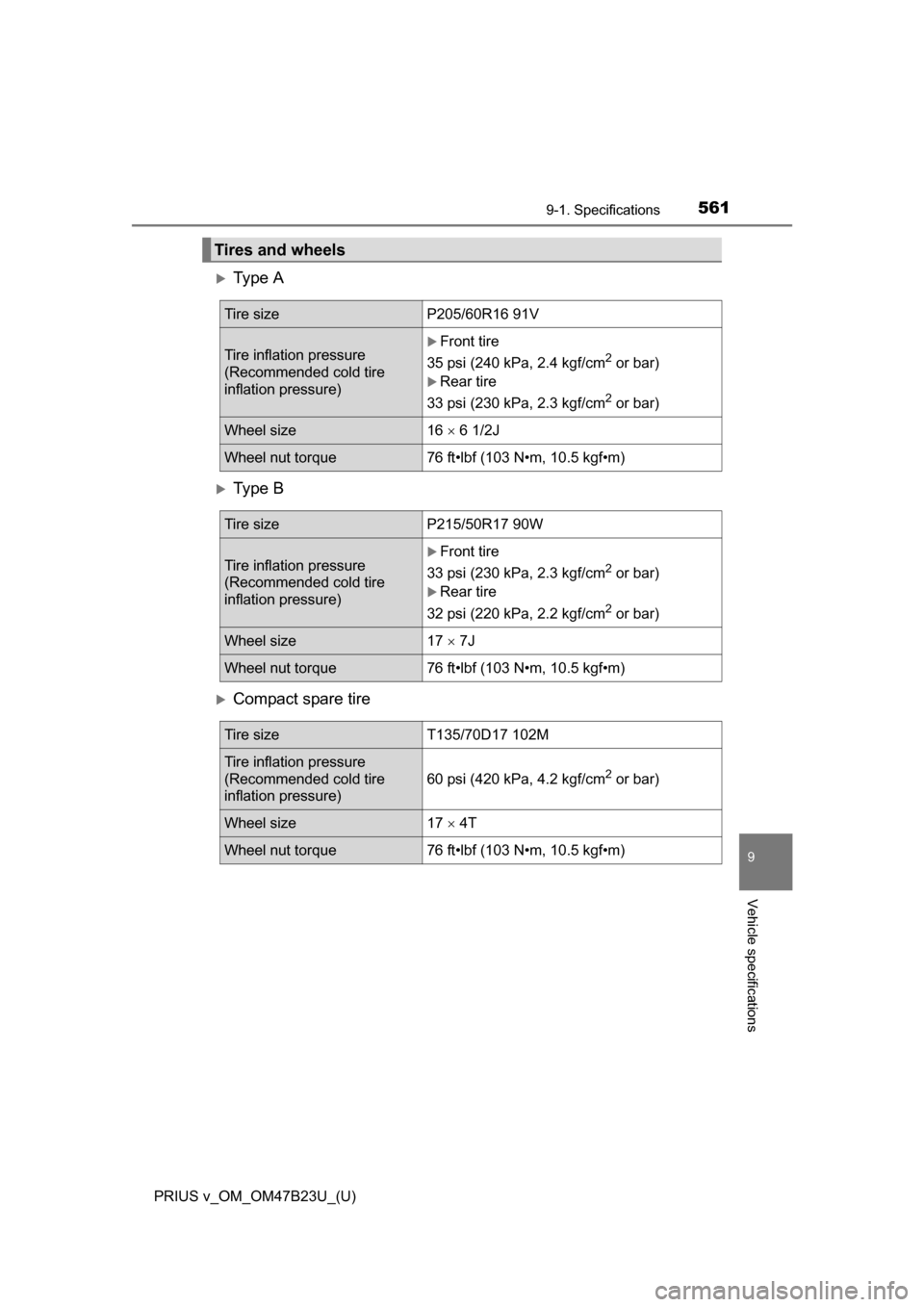
PRIUS v_OM_OM47B23U_(U)
5619-1. Specifications
9
Vehicle specifications
Ty p e A
Ty p e B
Compact spare tire
Tires and wheels
Tire sizeP205/60R16 91V
Tire inflation pressure
(Recommended cold tire
inflation pressure)Front tire
35 psi (240 kPa, 2.4 kgf/cm
2 or bar)
Rear tire
33 psi (230 kPa, 2.3 kgf/cm
2 or bar)
Wheel size16 6 1/2J
Wheel nut torque76 ft•lbf (103 N•m, 10.5 kgf•m)
Tire sizeP215/50R17 90W
Tire inflation pressure
(Recommended cold tire
inflation pressure)Front tire
33 psi (230 kPa, 2.3 kgf/cm
2 or bar)
Rear tire
32 psi (220 kPa, 2.2 kgf/cm
2 or bar)
Wheel size17 7J
Wheel nut torque76 ft•lbf (103 N•m, 10.5 kgf•m)
Tire sizeT135/70D17 102M
Tire inflation pressure
(Recommended cold tire
inflation pressure)
60 psi (420 kPa, 4.2 kgf/cm2 or bar)
Wheel size17 4T
Wheel nut torque76 ft•lbf (103 N•m, 10.5 kgf•m)
Page 562 of 624
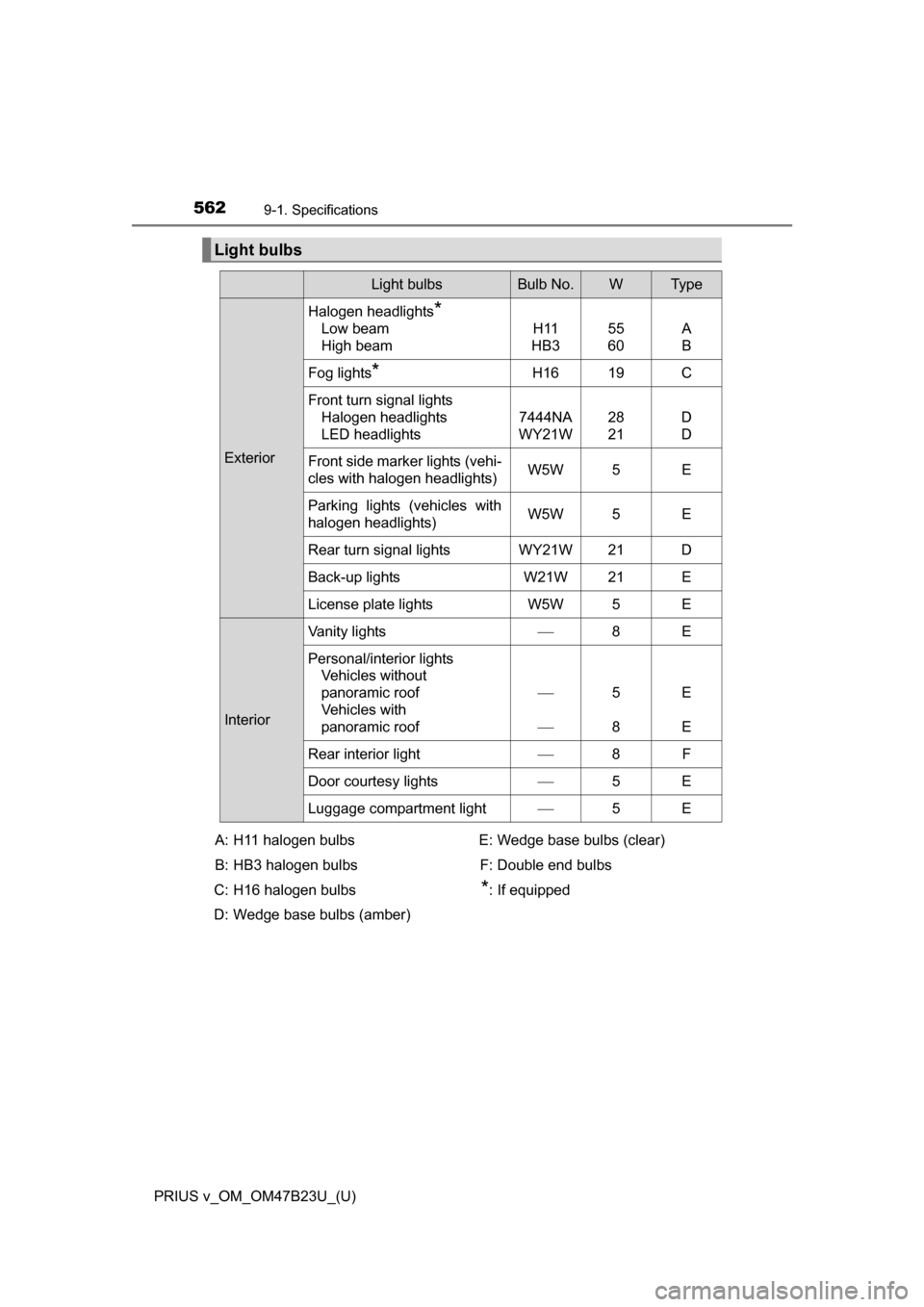
562
PRIUS v_OM_OM47B23U_(U)
9-1. Specifications
Light bulbs
Light bulbsBulb No.WTy p e
Exterior
Halogen headlights*
Low beam
High beamH11
HB355
60A
B
Fog lights*H1619C
Front turn signal lights Halogen headlights
LED headlights
7444NA
WY21W28
21D
D
Front side marker lights (vehi-
cles with halogen headlights)W5W5E
Parking lights (vehicles with
halogen headlights)W5W5E
Rear turn signal lightsWY21W21D
Back-up lightsW21W21E
License plate lightsW5W5E
Interior
Vanity lights8E
Personal/interior lights Vehicles without
panoramic roof
Vehicles with
panoramic roof
5
8E
E
Rear interior light8F
Door courtesy lights5E
Luggage compartment light5E
A: H11 halogen bulbs
B: HB3 halogen bulbs
C: H16 halogen bulbs
D: Wedge base bulbs (amber) E: Wedge base bulbs (clear)
F: Double end bulbs
*: If equipped
Page 563 of 624
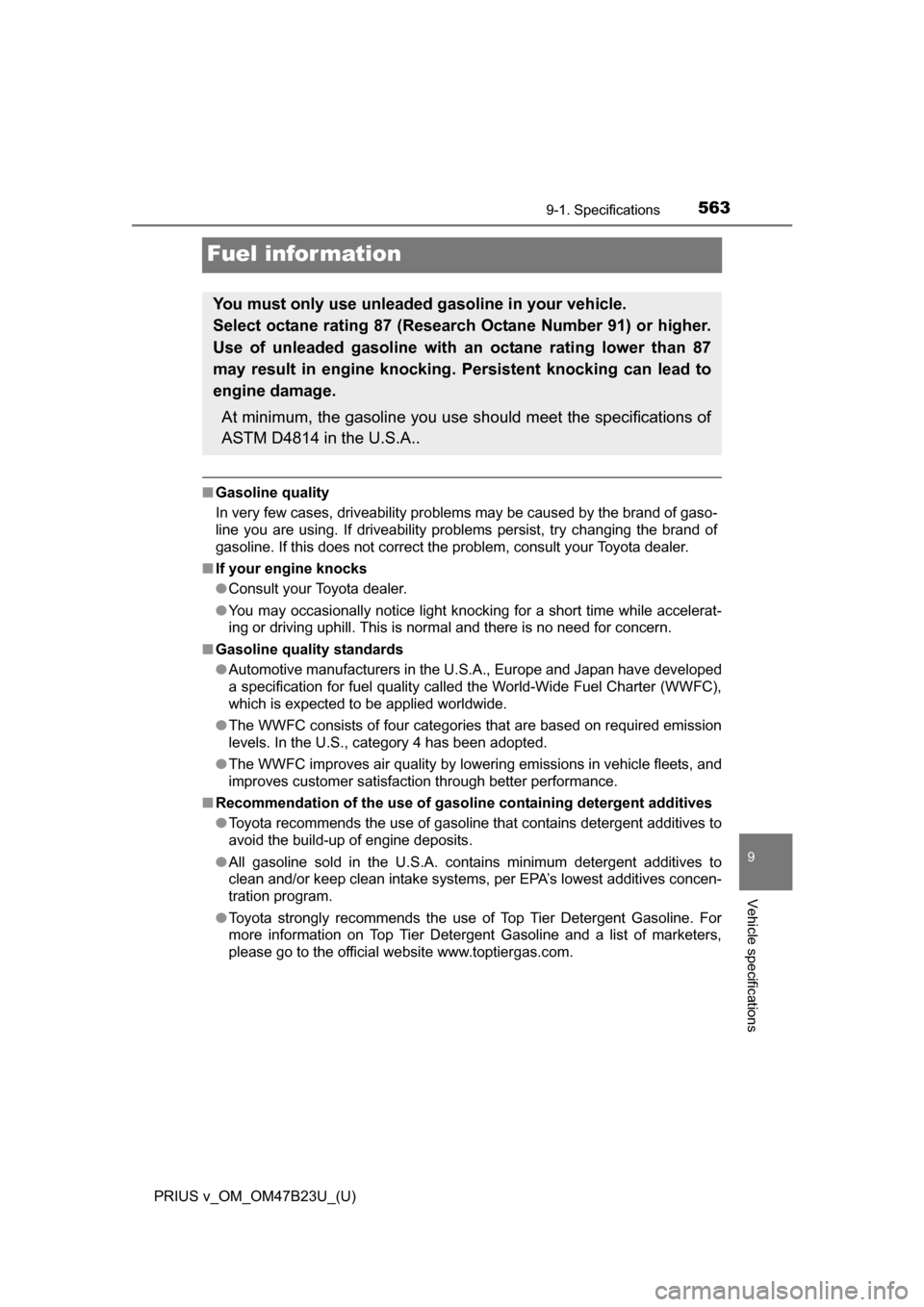
563
PRIUS v_OM_OM47B23U_(U)
9-1. Specifications
9
Vehicle specifications
Fuel information
■Gasoline quality
In very few cases, driveability problems may be caused by the brand of gaso-
line you are using. If driveability problems persist, try changing the brand of
gasoline. If this does not correct the problem, consult your Toyota dealer.
■ If your engine knocks
●Consult your Toyota dealer.
● You may occasionally notice light knocking for a short time while accelerat-
ing or driving uphill. This is normal and there is no need for concern.
■ Gasoline quality standards
●Automotive manufacturers in the U.S.A., Europe and Japan have developed
a specification for fuel quality called the World-Wide Fuel Charter (WWFC),
which is expected to be applied worldwide.
● The WWFC consists of four categories that are based on required emission
levels. In the U.S., category 4 has been adopted.
● The WWFC improves air quality by lowering emissions in vehicle fleets, and
improves customer satisfaction through better performance.
■ Recommendation of the use of gaso line containing detergent additives
● Toyota recommends the use of gasoline that contains detergent additives to
avoid the build-up of engine deposits.
● All gasoline sold in the U.S.A. contains minimum detergent additives to
clean and/or keep clean intake systems, per EPA’s lowest additives concen-
tration program.
● Toyota strongly recommends the use of Top Tier Detergent Gasoline. For
more information on Top Tier Detergent Gasoline and a list of marketers,
please go to the official website www.toptiergas.com.
You must only use unleaded gasoline in your vehicle.
Select octane rating 87 (Research Octane Number 91) or higher.
Use of unleaded gasoline with an octane rating lower than 87
may result in engine knocking. Persistent knocking can lead to
engine damage.
At minimum, the gasoline you use s hould meet the specifications of
ASTM D4814 in the U.S.A..
Page 564 of 624
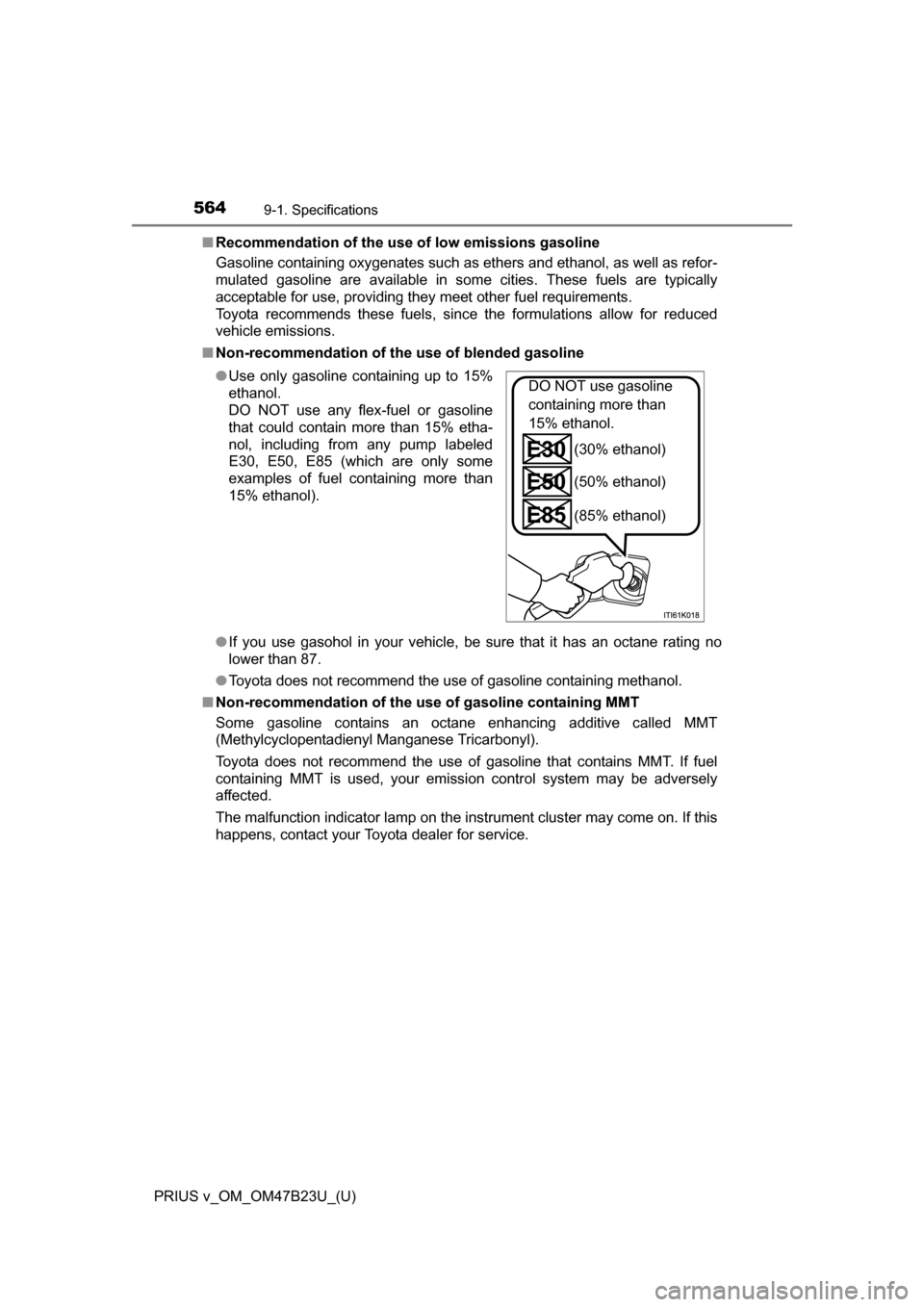
564
PRIUS v_OM_OM47B23U_(U)
9-1. Specifications
■Recommendation of the use of low emissions gasoline
Gasoline containing oxygenates such as ethers and ethanol, as well as refor-
mulated gasoline are available in some cities. These fuels are typically
acceptable for use, providing they meet other fuel requirements.
Toyota recommends these fuels, since the formulations allow for reduced
vehicle emissions.
■ Non-recommendation of the use of blended gasoline
●If you use gasohol in your vehicle, be sure that it has an octane rating no
lower than 87.
● Toyota does not recommend the use of gasoline containing methanol.
■ Non-recommendation of the use of gasoline containing MMT
Some gasoline contains an octane enhancing additive called MMT
(Methylcyclopentadienyl Manganese Tricarbonyl).
Toyota does not recommend the use of gasoline that contains MMT. If fuel
containing MMT is used, your emission control system may be adversely
affected.
The malfunction indicator lamp on the instrument cluster may come on. If this
happens, contact your Toyota dealer for service. ●Use only gasoline containing up to 15%
ethanol.
DO NOT use any flex-fuel or gasoline
that could contain more than 15% etha-
nol, including from any pump labeled
E30, E50, E85 (which are only some
examples of fuel containing more than
15% ethanol).
DO NOT use gasoline
containing more than
15% ethanol.
(30% ethanol)
(50% ethanol)
(85% ethanol)
Page 565 of 624
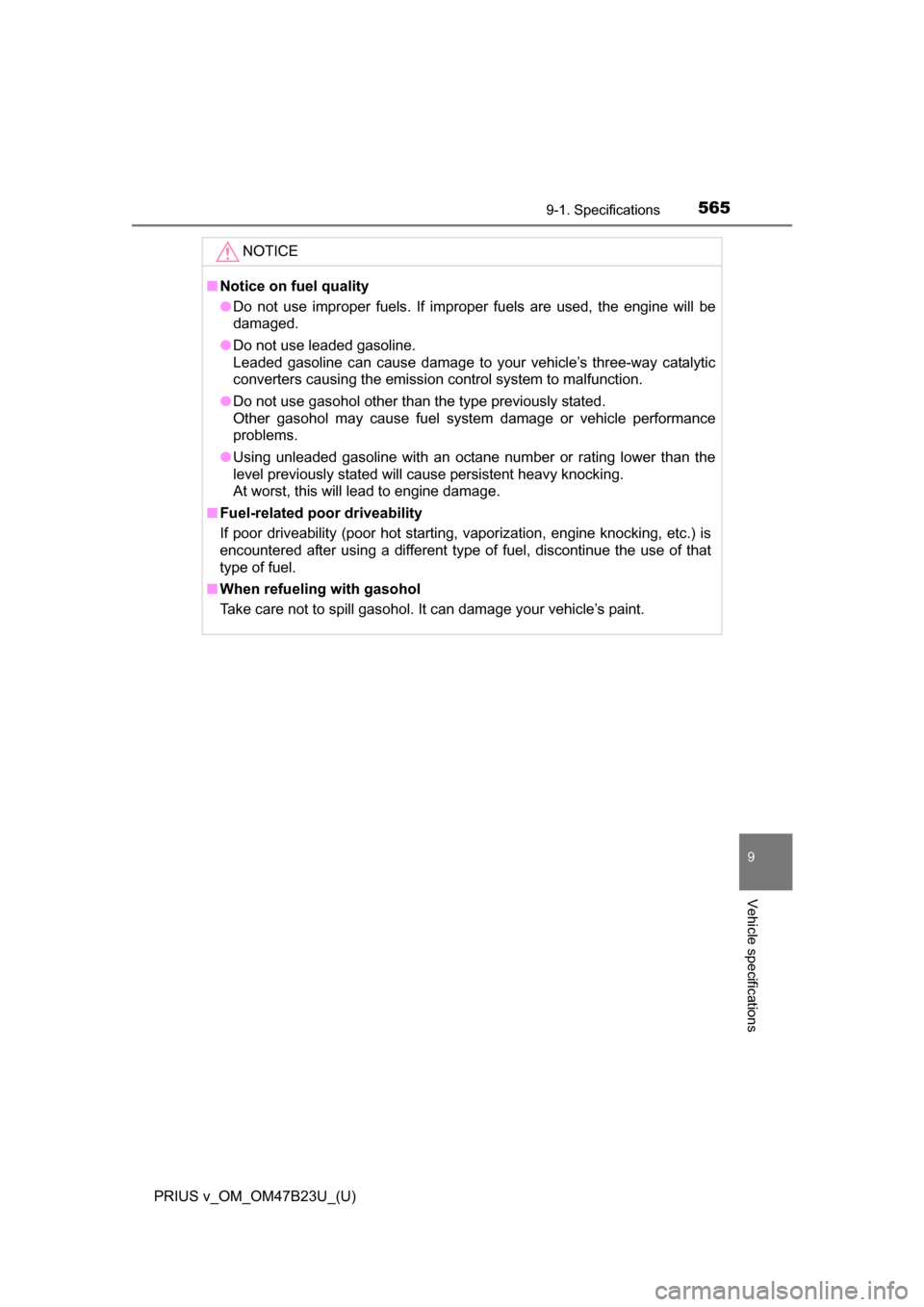
PRIUS v_OM_OM47B23U_(U)
5659-1. Specifications
9
Vehicle specifications
NOTICE
■Notice on fuel quality
●Do not use improper fuels. If improper fuels are used, the engine will be
damaged.
● Do not use leaded gasoline.
Leaded gasoline can cause damage to your vehicle’s three-way catalytic
converters causing the emission control system to malfunction.
● Do not use gasohol other than the type previously stated.
Other gasohol may cause fuel system damage or vehicle performance
problems.
● Using unleaded gasoline with an octane number or rating lower than the
level previously stated will cause persistent heavy knocking.
At worst, this will lead to engine damage.
■ Fuel-related poor driveability
If poor driveability (poor hot starting, vaporization, engine knocking, etc.) is
encountered after using a different type of fuel, discontinue the use of that
type of fuel.
■ When refueling with gasohol
Take care not to spill gasohol. It can damage your vehicle’s paint.
Page 566 of 624
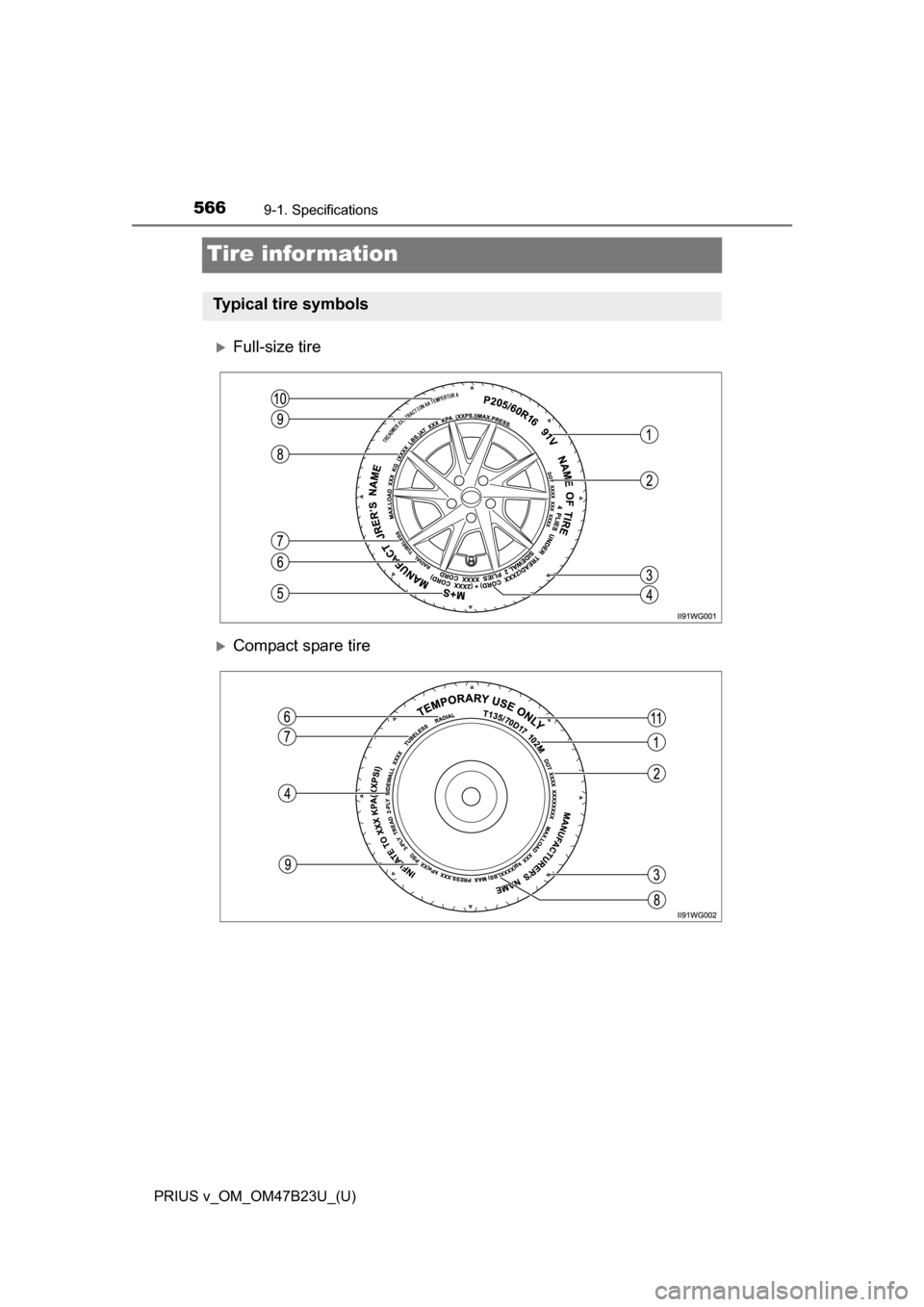
566
PRIUS v_OM_OM47B23U_(U)
9-1. Specifications
Tire information
Full-size tire
Compact spare tire
Typical tire symbols
Page 567 of 624
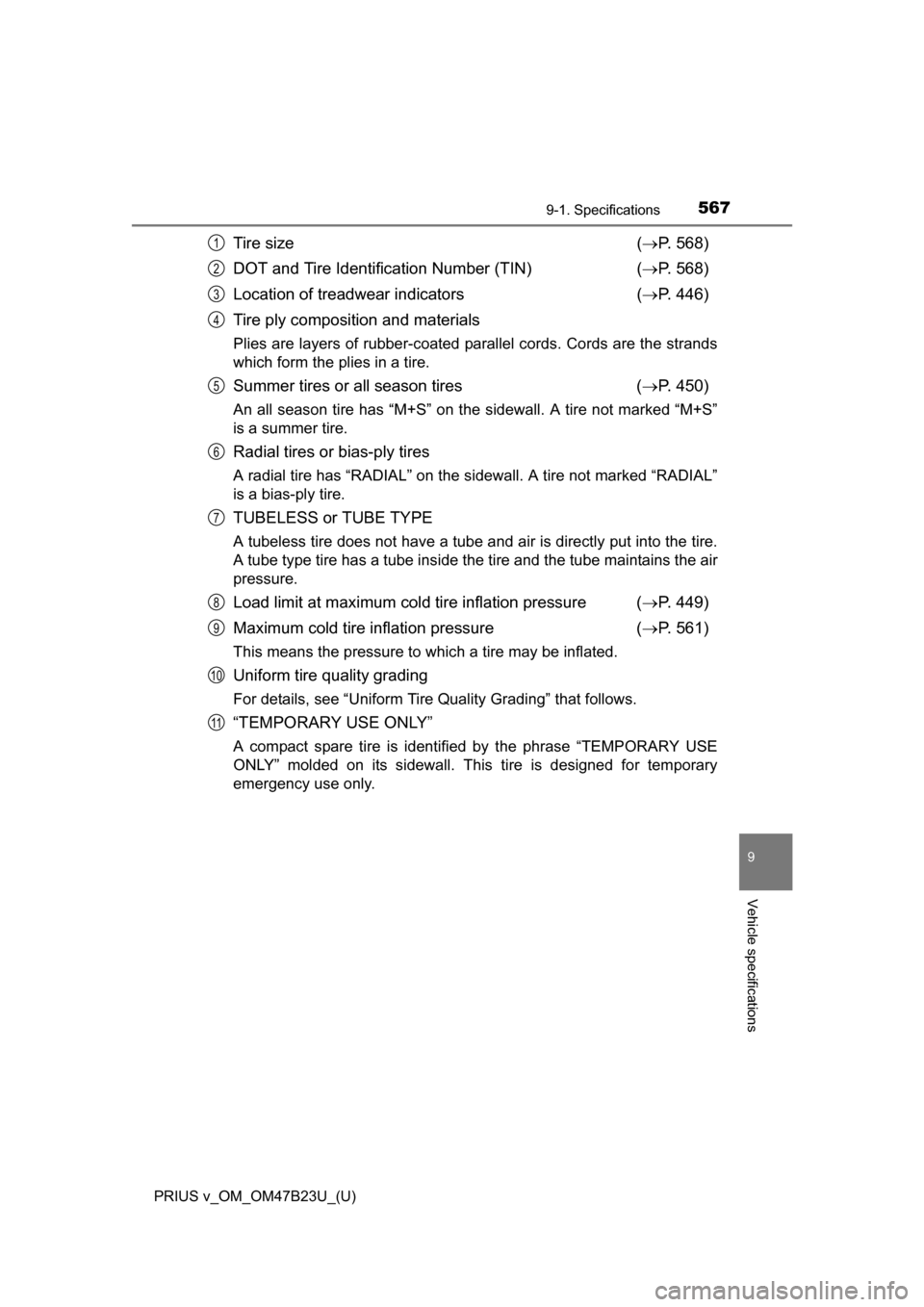
PRIUS v_OM_OM47B23U_(U)
5679-1. Specifications
9
Vehicle specifications
Tire size( P. 568)
DOT and Tire Identification Number (TIN) ( P. 568)
Location of treadwear indicators ( P. 446)
Tire ply composition and materials
Plies are layers of rubber-coated parallel cords. Cords are the strands
which form the plies in a tire.
Summer tires or all season tires ( P. 450)
An all season tire has “M+S” on the sidewall. A tire not marked “M+S”
is a summer tire.
Radial tires or bias-ply tires
A radial tire has “RADIAL” on the sidewall. A tire not marked “RADIAL”
is a bias-ply tire.
TUBELESS or TUBE TYPE
A tubeless tire does not have a tube and air is directly put into the tire.
A tube type tire has a tube inside the tire and the tube maintains the air
pressure.
Load limit at maximum cold tire inflation pressure ( P. 449)
Maximum cold tire inflation pressure ( P. 561)
This means the pressure to which a tire may be inflated.
Uniform tire quality grading
For details, see “Uniform Tire Quality Grading” that follows.
“TEMPORARY USE ONLY”
A compact spare tire is identified by the phrase “TEMPORARY USE
ONLY” molded on its sidewall. This tire is designed for temporary
emergency use only.
1
2
3
4
5
6
7
8
9
10
11
Page 568 of 624
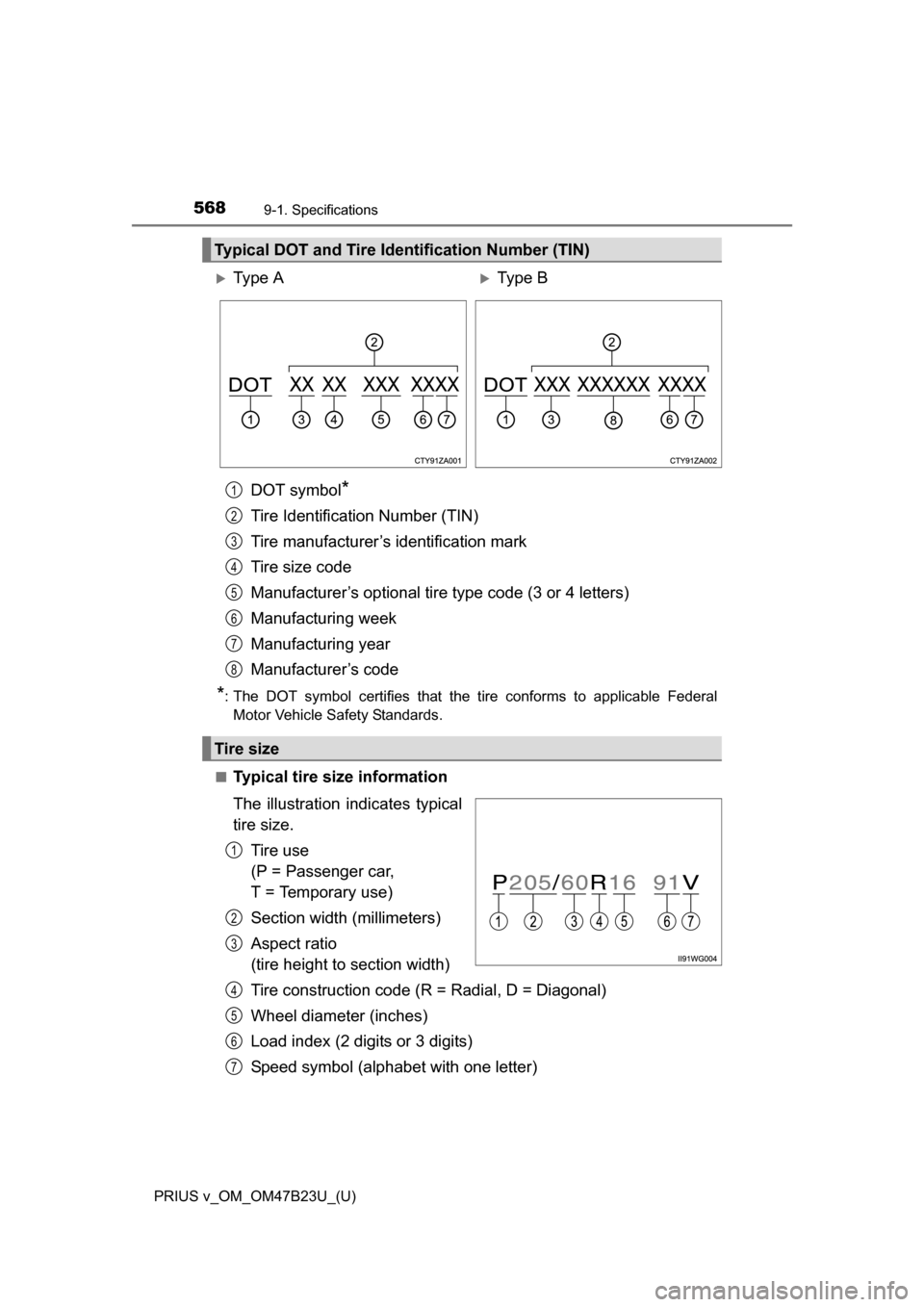
568
PRIUS v_OM_OM47B23U_(U)
9-1. Specifications
DOT symbol*
Tire Identification Number (TIN)
Tire manufacturer’s identification mark
Tire size code
Manufacturer’s optional tire type code (3 or 4 letters)
Manufacturing week
Manufacturing year
Manufacturer’s code
*: The DOT symbol certifies that the tire conforms to applicable Federal Motor Vehicle Safety Standards.
■
Typical tire size information
The illustration in dicates typical
tire size.
Tire use
(P = Passenger car,
T = Temporary use)
Section width (millimeters)
Aspect ratio
(tire height to section width)
Tire construction code (R = Radial, D = Diagonal)
Wheel diameter (inches)
Load index (2 digits or 3 digits)
Speed symbol (alphabet with one letter)
Typical DOT and Tire Identification Number (TIN)
Ty p e AType B
Tire size
1
2
3
4
5
6
7
8
1
2
3
4
5
6
7
Page 569 of 624
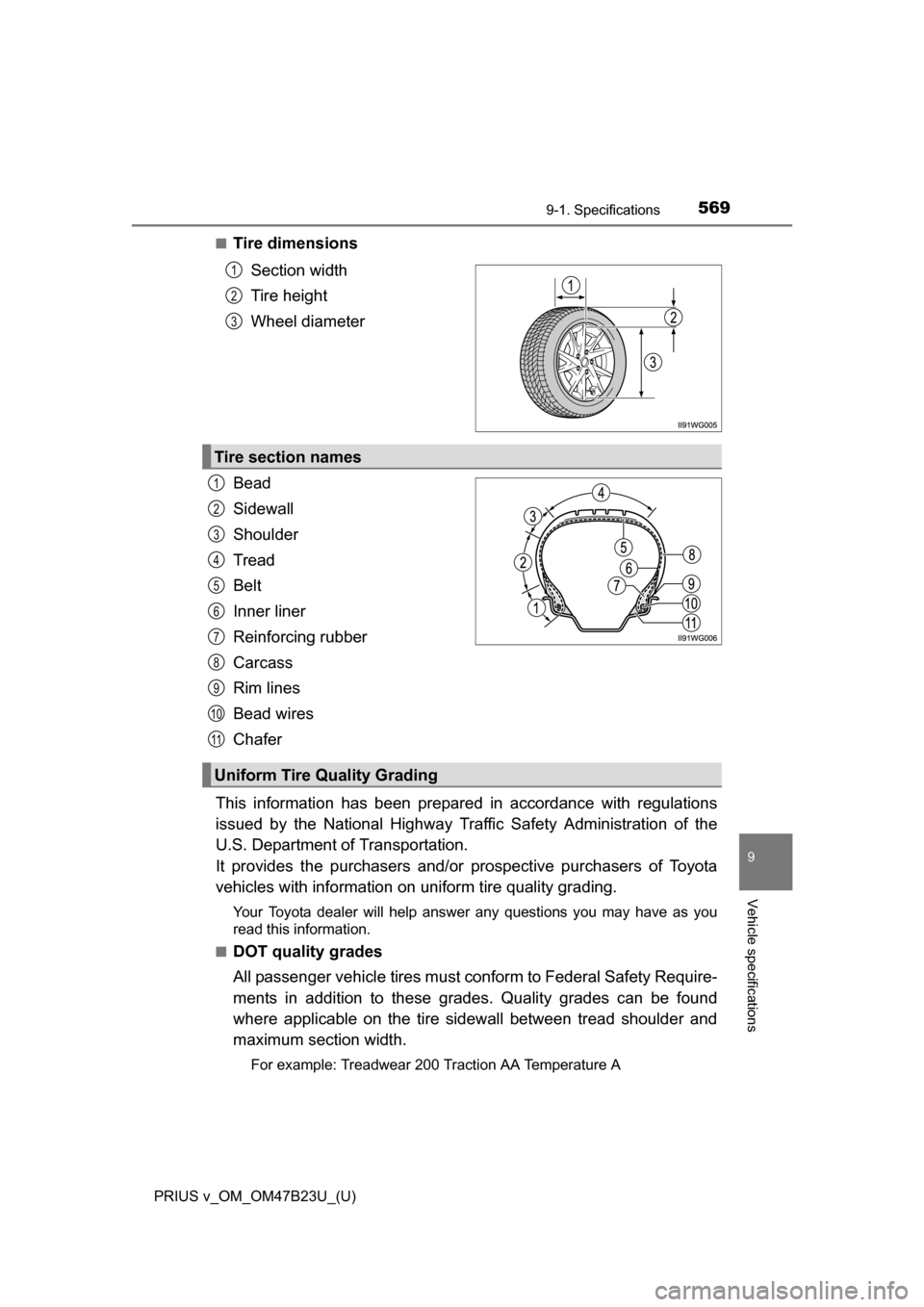
PRIUS v_OM_OM47B23U_(U)
5699-1. Specifications
9
Vehicle specifications
■Tire dimensionsSection width
Tire height
Wheel diameter
Bead
Sidewall
Shoulder
Tread
Belt
Inner liner
Reinforcing rubber
Carcass
Rim lines
Bead wires
Chafer
This information has been prepared in accordance with regulations
issued by the National Highway Tr affic Safety Administration of the
U.S. Department of Transportation.
It provides the purchasers and/or prospective purchasers of Toyota
vehicles with information on uniform tire quality grading.
Your Toyota dealer will help answer any questions you may have as you
read this information.
■
DOT quality grades
All passenger vehicle tires must c onform to Federal Safety Require-
ments in addition to these grades. Quality grades can be found
where applicable on the tire sidewall between tread shoulder and
maximum section width.
For example: Treadwear 200 Traction AA Temperature A
1
2
3
Tire section names
1
2
3
4
5
6
7
Uniform Tire Quality Grading
8
9
10
11
Page 570 of 624
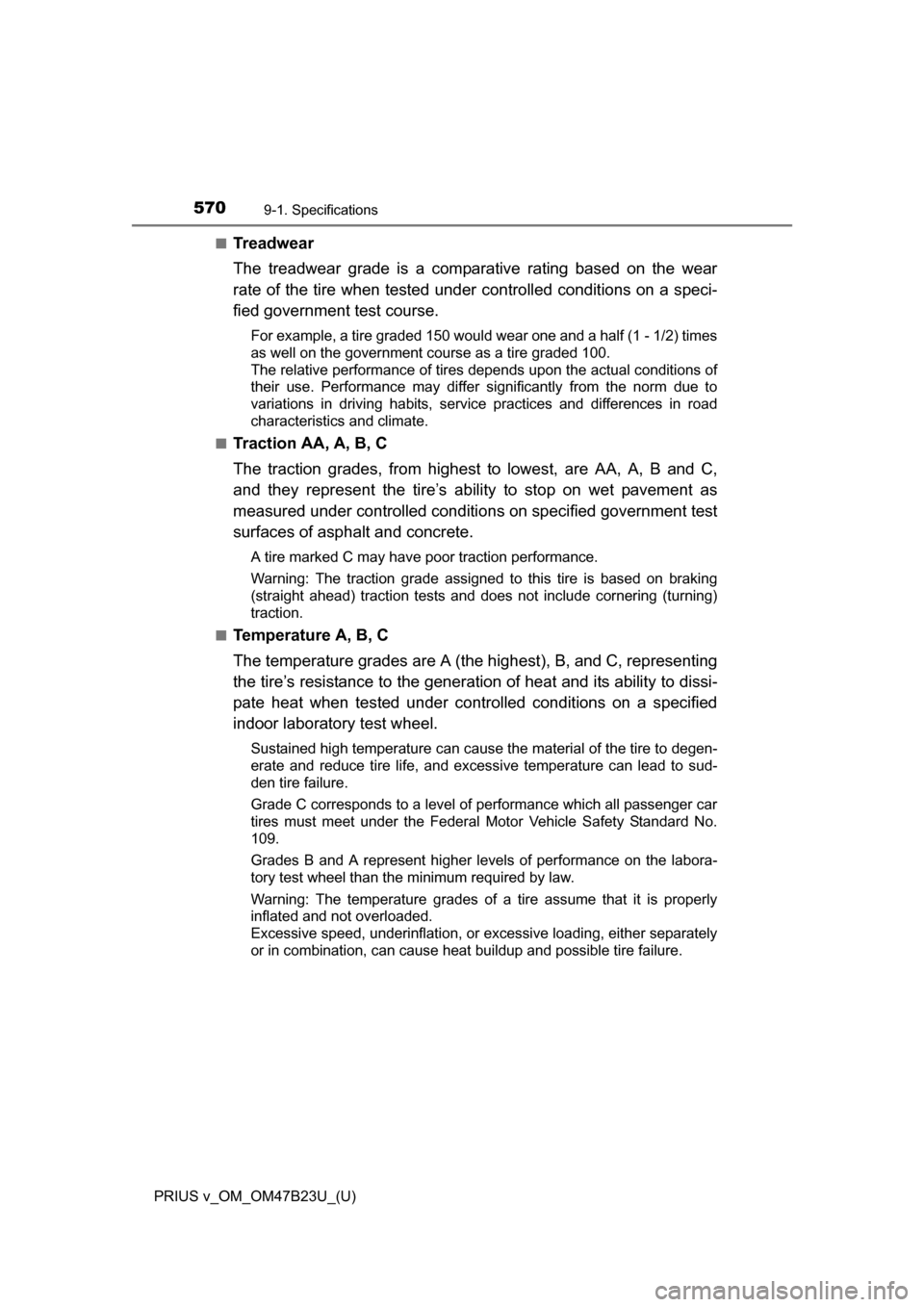
570
PRIUS v_OM_OM47B23U_(U)
9-1. Specifications
■Treadwear
The treadwear grade is a comparative rating based on the wear
rate of the tire when tested under controlled conditions on a speci-
fied government test course.
For example, a tire graded 150 would wear one and a half (1 - 1/2) times
as well on the government course as a tire graded 100.
The relative performance of tires depends upon the actual conditions of
their use. Performance may differ significantly from the norm due to
variations in driving habits, service practices and differences in road
characteristics and climate.
■
Traction AA, A, B, C
The traction grades, from highest to lowest, are AA, A, B and C,
and they represent the tire’s ability to stop on wet pavement as
measured under controlled conditio ns on specified government test
surfaces of asphalt and concrete.
A tire marked C may have poor traction performance.
Warning: The traction grade assigned to this tire is based on braking
(straight ahead) traction tests and does not include cornering (turning)
traction.
■
Temperature A, B, C
The temperature grades are A (the hi ghest), B, and C, representing
the tire’s resistance to the generation of heat and its ability to dissi-
pate heat when tested under cont rolled conditions on a specified
indoor laboratory test wheel.
Sustained high temperature can cause the material of the tire to degen-
erate and reduce tire life, and excessive temperature can lead to sud-
den tire failure.
Grade C corresponds to a level of performance which all passenger car
tires must meet under the Federal Motor Vehicle Safety Standard No.
109.
Grades B and A represent higher levels of performance on the labora-
tory test wheel than the minimum required by law.
Warning: The temperature grades of a tire assume that it is properly
inflated and not overloaded.
Excessive speed, underinflation, or excessive loading, either separately
or in combination, can cause heat buildup and possible tire failure.